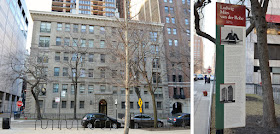The John W. Root House (1888) is located in Chicago’s Gold Coast neighborhood, across the street and down the block from the Charnley House. The following text about Root is taken from the Chicago Tribute – Markers of Distinction:
John Wellborn Root (1850–1891), Architect
John Wellborn Root’s architectural designs helped to establish Chicago as the birthplace of modern architecture. After the Great Fire of 1871, Root came here from New York City to take part in the rebuilding of Chicago. He met Daniel H. Burnham and they formed a partnership considered one of the most important in architectural history. During their 18 years together, Burnham and Root designed more than 300 buildings, many in Chicago’s Loop.
The firm began with residential commissions, but soon was asked to design commercial buildings. Their first important downtown building was the Montauk Building, where Root used a technologically innovative grillage of iron rails that distributed the building's weight over the entire ground area.
Root’s designs often showed an honest expression of a building’s structure and deemphasized exterior ornament. His work includes two of the finest examples of the Chicago school of design: the Rookery Building and the Monadnock Block. The sparsely adorned Monadnock remains the world’s tallest office building with load-bearing walls.
Root, who lived at 1310 North Astor Street, died of pneumonia at the age of 41. At the time, Burnham and Root were working on the site planning and architectural themes for the World's Columbian Exposition.






























